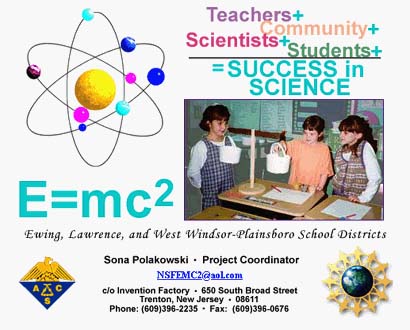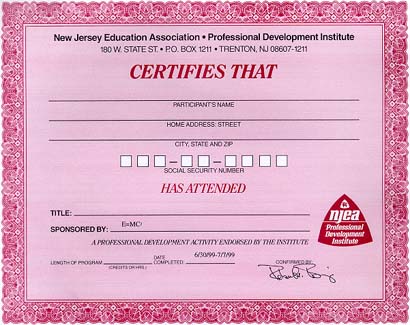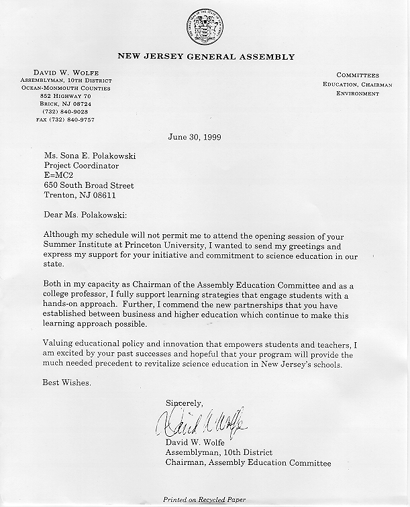|
submitter:
|
E=MC2
|
|
published:
|
08/20/1999
|
|
posted to site:
|
08/20/1999
|
E=MC2
How long do your workshops last?
1/2, full day, and week long.
How many teachers do you involve in your workshops?
Over 570.
What are your major goals for your workshops in terms of content and pedagogy? (Just one or two paragraphs)
See attached.
Are you offering professional development on specific curricula that you are hoping will be used in the classroom? If so, which curricula are you using?
Yes. See attached.

E=MC2 Kits
| Grade |
Kits |
Publisher |
Districts |
| K |
LIVING THINGS
BALLS AND RAMPS
MYSELF & OTHERS |
Insights
Insights
Insights |
Lawrence, West Windsor-Plainsboro & Ewing
Lawrence & Ewing
Lawrence |
| 1 |
SOLIDS & LIQUID
AIR AND WEATHER
ORGANISMS
ROCKS, SAND & SOIL |
FOSS
FOSS
STC
Creative Publications |
Lawrence
Lawrence & Ewing
Lawrence, West Windsor-Plainsboro & Ewing
West Windsor-Plainsboro |
| 2 |
BALANCING & WEIGHING
LIFE CYCLE OF BUTTERFLY
PEBBLES, SAND, & SILT
INSECTS
CHANGES |
STC
STC
FOSS
FOSS
STC |
Lawrence, West Windsor-Plainsboro & Ewing
Lawrence
Lawrence & Ewing
West Windsor-Plainsboro & Ewing
West Windsor-Plainsboro |
| 3 |
EARTH MATERIALS
HUMAN BODY
WATER
PLANT GROWTH & DEVELOPMENT
CHEMICAL TESTS
SOUNDS |
FOSS
FOSS
FOSS
STC
STC
STC |
Lawrence & Ewing
Lawrence
Lawrence
West Windsor-Plainsboro & Ewing
West Windsor-Plainsboro & Ewing
West Windsor-Plainsboro |
| 4 |
STRUCTURES OF LIFE
ELECTRIC CIRCUITS
MOTION & DESIGNS
ROCKS & MINERALS
ECOSYSTEMS
MICROWORLDS |
FOSS
STC
FOSS
STC
STC
STC |
Lawrence
Lawrence, West Windsor-Plainsboro & Ewing
Lawrence
West Windsor-Plainsboro
West Windsor-Plainsboro
Ewing |
| 5 |
MICROWORLDS
ECOSYSTEMS
MIXTURE & SOLUTIONS
LANDFORMS
VARIABLES |
STC
STC
FOSS
FOSS
FOSS |
Lawrence & West-Windsor-Plainsboro
Lawrence & Ewing
West Windsor-Plainsboro & Ewing
Ewing
West Windsor-Plainsboro |
| 6 |
MIXTURES & SOLUTIONS
MAGNETS & MOTORS
MODELS & DESIGNS
LAND & WATER
VARIABLES
OCEANOGRAPHY |
FOSS
STC
FOSS
STC
FOSS
Lawrence |
Lawrence
Lawrence, West Windsor-Plainsboro & Ewing
West Windsor-Plainsboro
West Windsor-Plainsboro
Ewing
Lawrence |
E=MC2
Invention Factory Science Center
650 South Broad Street, Tranton, NJ 08611
Phone: 609-396-2235 Fax: 609-0676
E-mail - NSFEMC2@aol.com
Web site: http://www.inventionfactory.com/emc2
Summer NSF Science Institute Part A
June 30th - July 7th
Goals And Objectives
Clapping Game
To look at different ways assessment can be designed.
To explore the way these designs affect how the assessor and assessee feel the consequences of how we do assessment.
To develop an awareness and a better understanding of the pros and cons of involving students in their own assessment.
Foam Activity
To have an experience in restructuring a guided activity to make it more open ended.
Foam Activity is just a tool.
Setting the Stage
To identify characteristics of an exemplary elementary school science education.
To identify key elements needed for science reform.
To identify strategies for teaching and learning inquiry-centered science.
To learn about the implementations of science reform in Ewing, Lawrence, and West Windsor Plainsboro Districts.
Modules
Communication Connections
Christine Pancari and Susan Pantone
To develop an understanding of the importance of communicating information.
To become familiar with a variety of forms of communication in the science classroom.
To provide participants with an opportunity to review what they have learned and to plan for application of knowledge.
Assessing Science Outcomes
Mary Lou Byer and Donna Lawrance
To investigate methods for monitoring students progress and share ways to communicate.
To the major stake holders i.e. administrators, students, parents, teachers and community.
To identify the processes of science education.
To provide teachers with an understanding of how assess the processes of science and communicate the change to stake holders.
To appreciate the varied assortments of assessment tools available for different assessment tasks.
Caution, Knowledge Under Construction
Eileen Randall and Barbara Pakradooni
To explore some techniques useful for revealing student misconception.
To become familiar with conditions that facilitate conceptual change.
To describe the general features of the Constructivist Learning Model.
To relate the Constructivist LEarning Model to the processes of science.
Inquiry-based Science: The Guide on the Side.
Jessica Heller and Mary Miller
To introduce the concept of "Inquiry as an Instructional Approach" and model how it can be used in instruction.
To introduce strategies that promote inquiry in hands-on science.
To compare a structured vs. Open-ended inquiry approach to science.
The Nature of Science: Questions, Questions, Questions
Jan Fay and Carole Bridges
To inform participants of basic concepts about the nature of science.
To provide information so that participants can incorporate these concepts into their instruction.
To model open-ended science investigations that reflect the nature of science.
To provide guided practice in developing and conducting investigations.
Benchmarks
May Jo Gonsiorowski and Wanda Rinker
To inform participants about the development of Benchmarks.
To inform participants about the components of Benchmarks.
To demonstrate ho hands-on activities in the new science curriculum address the Banchmarks, the National Standards, and the New Jersey State Standards.
To Provide information about the relationship of the national standards to Benchmarks and the science curriulum.
To provide information about the relationship of the state standards to Benchmarks and the science curriculum.
IFSC
Judy Winkler
To follow and observe the process of kit handling and refurbishment in the center's materials and resource center, Science to Go!
To appreciate the importance of materials support in science reform.
To learn about computer, internet, and other resources connections available to educators.
To become aware of the plans for the development of the former machine shop of the Roebling Steel Works, site of the further science museum.
To appreciate the importance of historical preservation and urban renewal, and community support in science education.
Summer NSF Science Institute Part A Schedule June 30 to July 7, 1999
| Wednesday |
Thursday |
Friday |
Tuesday |
Wednesday |
McDonnell Building
Princeton University |
Lawrence Intermediate School |
Lawrence Intermediate School |
Lawrence Intermediate School |
Lawrence Intermediate School |
8:00-8:30 am
Sign In - Continental Breakfast |
8:00-8:30 am
Sign In - Continental Breakfast |
8:00-8:30 am
Sign In - Continental Breakfast |
8:00-8:30 am
Sign In - Continental Breakfast |
8:00-8:30 am
Sign In - Continental Breakfast |
8:30
Introduction, Presentations & Speakers
A 01 Auditorium |
8:30-11:30
Module
See rotation schedule on reverse side |
8:30-11:30
Module
See rotation schedule on reverse side |
8:30-11:30
Module
See rotation schedule on reverse side |
8:30-11:30
Module
See rotation schedule on reverse side |
| 9:45 Break |
10:00 - Breakout Groups
Group I: *Red & Dusty Rose*
Room 101
Group II: *Green & Blue*
Room 102 |
| LUNCH |
12:30-3:30
Ice Balloons: Guided, Discovery and Inquiry Activity
Breakout Groups
Room 101-Dusty Rose
Room 102-Blue
Room 103-Green
Room 104-Red |
12:30-3:30
Module
See rotation schedule on reverse side |
12:30-3:30
Module
See rotation schedule on reverse side |
12:30-3:30
Module
See rotation schedule on reverse side |
12:30-3:30
Bus leaves at 12:30
Field Trip Invention Factory Science Center |
| |
Wednesday |
Thursday |
Friday |
Tuesday |
Wednesday A.M. |
| |
|
A.M. |
P.M. |
A.M. |
P.M. |
A.M. |
P.M. |
|
| Caution, Knowledge Under Construction Room 56 |
KICK OFF |
RED |
GREEN |
XXXXX |
XXXXX |
BLUE |
DUSTY ROSE |
Red
Foam Activity
Making the transition from Kits to Inquiry |
| Inquiry-based Science: Guide on the Side Room 57 |
|
GREEN |
RED |
XXXXX |
XXXXX |
DUSTY ROSE |
BLUE |
Green
Foam Activity
Making the transition from Kits to Inquiry |
| Assessing Science Outcomes Room 54 |
|
BLUE |
DUSTY ROSE |
RED |
GREEN |
XXXXX |
XXXXX |
Blue
Foam Activity
Making the transition from Kits to Inquiry |
| Communication Connections Room 53 |
|
DUSTY ROSE |
BLUE |
GREEN |
RED |
XXXXX |
XXXXX |
Dusty Rose
Foam Activity
Making the transition from Kits to Inquiry |
| Benchmarks N.J. State Core Standards Room 60 |
|
XXXXX |
XXXXX |
BLUE |
DUSTY ROSE |
RED |
GREEN |
Wednesday P.M.
1:00-3:00 pm
Invention Factory Science Center
History and Development
Refreshments and Wrap-Up
Return to LIS |
| The Nature Of Science: Questions, Questions, Questions Room 58 |
|
XXXXX |
XXXXX |
DUSTY ROSE |
BLUE |
GREEN |
RED |
Bus #1
Red and Green
Bus #2
Blue and Dusty Rose |
Summer Institute - Part B
July 26 - 30, 1999
Goals and Objectives
Rob Staats - Multimedia
- To develop an understanding of the various methods and multimedia resources available for communicating science information.
- To plan and develop a multimedia science project which demonstrates knowledge of the concepts contained in one NSF module.
Pete Christ - Powerful Learning and Simulations Software
- To identify the elements of simulation software
- To utilize a tool to evaluate software for appropriateness and grade level.
- To identify at least one piece of software that will be useful in your classroom.
- To identify ways to incorporate of a piece of software into a current lesson, unit or activity already being done in your classroom.
Walt Dimitruk - Multimedia II
- The students will be able to successfully operate video equipment.
- The students will be able to connect video equipment to a computer.
- The students will be able to record voth video and still images during the science lesson presented.
- The students will be able to create a multimedia presentation using the videos and images they have collected.
Arlene Harris - IBM Formatted
- To feel comfortable using a computer.
- To learn to use a IBM formatted computer.
- To use many skills in the Microsoft Office applications.
- To feel comfortable using the computer as a tool to enrich science activities with students.
- To use the computer as a tool for recording scientific data.
Sharon Feig and Sharon Zubricky - ClarisWorks
- To develop an understanding of how ClarisWorks can be utilized for analyzing and communicating scientific information.
- To identify ways to incorporate ClarisWorks into a science unit, lesson or activity.
- To enhance the student's ability to use the ClarisWorks word processing program.
- To expand the student's knowledge of the components and uses of the ClarisWorks data base and spreadsheet programs.
William Lazzaro - Assessment
- Empowering Students with instructional Rubrics
- Scoring Rubric vs. Instructional Rubric
- Instructional Rubric defined
- What are the relative influences on student learning?
- Student Samples with and without rubrics
- Improving Student Achievement ... Realistic Expectations
Rebecca Gold - Internet
- To learn to navigate the Internet using search engines, browser software and printed reference materials to locate information relevant to the science kits being used.
- To visit known Internet sites and locate additional resources that enhance the science kits being used in the classrooms.
- To explore educational sites, with relation to the kits that teachers are using, that share class science projects, lesson plansand offer group interaction for online projects.
Part B Schedule 1999
| NSF Summer Institute Session I July 26-30 |
| |
Monday - July 26 |
Tuesday - July 27 |
Wednesday - July 28 |
Thursday - July 29 |
Friday - July 30 |
| Group |
8:30 am - 11:30 am |
8:30 am - 11:30 am |
8:30 am - 11:30 am |
8:30 am - 11:30 am |
8:30 am - 11:30 am |
| I A RED |
Multimedia I
Rob Staats
Room 117
(downstairs)
Ewing High School
|
Internet
Rebecca Gold
Room 200
(upstairs)
Ewing High School
|
Microsoft
Arlene Harris
Room 225
(upstairs)
Ewing High School
|
Science Assessment
Bill Lazzaro
Senior Cafe
Ewing High School
|
Science Assessment
Bill Lazzaro
Senior Cafe
Ewing High School
|
| I B GREEN |
Software
Peter Christ
Room 225
(upstairs)
Ewing High School
|
Multimedia II
Walt Dimitruk
Room 302
(downstairs)
Ewing High School
|
ClarisWorks
Sharon Feig
Room 117
(downstairs)
Ewing High School
|
Science Assessment
Bill Lazzaro
Senior Cafe
Ewing High School
|
Science Assessment
Bill Lazzaro
Senior Cafe
Ewing High School
|
| I C BLUE |
Internet
Rebecca Gold
Room 200
(upstairs)
Ewing High School
|
Multimedia I
Rob Staats
Room 117
(downstairs)
Ewing High School
|
ClarisWorks
Sharon Zubricki
Room 200
(upstairs)
Ewing High School
|
Science Assessment
Bill Lazzaro
Senior Cafe
Ewing High School
|
Science Assessment
Bill Lazzaro
Senior Cafe
Ewing High School
|
| |
12:30 pm - 3:30 pm |
12:30 pm - 3:30 pm |
12:30 pm - 3:30 pm |
12:30 pm - 3:30 pm |
12:30 pm - 3:30 pm |
| I A RED |
Multimedia II
Walt Dimitruk
Room 302
(downstairs)
Ewing High School
|
Software
Peter Christ
Room 225 (upstairs)
Ewing High School
|
Science Assessment
Bill Lazzaro
Senior Cafe
Ewing High School
|
Science Assessment
Bill Lazzaro
Senior Cafe
Ewing High School
|
Science Assessment
Bill Lazzaro
Senior Cafe
Ewing High School
|
| I B GREEN |
Multimedia I
Rob Staats
Room 117
(downstairs)
Ewing High School
|
Internet
Rebecca Gold
Room 200
(upstairs)
Ewing High School
|
Science Assessment
Bill Lazzaro
Senior Cafe
Ewing High School
|
Science Assessment
Bill Lazaro
Senior Cafe
Ewing High School
|
Science Assessment
Bill Lazzaro
Senior Cafe
Ewing High School
|
| I C BLUE |
Software
Peter Christ
Room 225
(upstairs)
Ewing High School
|
Multimedia II
Walt Dimitruk
Room 302
(downstairs)
Ewing High School
|
Science Assessment
Bill Lazzaro
Senior Cafe
Ewing High School
|
Science Assessment
Bill Lazzaro
Senior Cafe
Ewing High School
|
Science Assessment
Bill Lazzaro
Senior Cafe
Ewing High School
|
| NSF Summer Institute Session July 26-30 |
| |
Monday - July 26 |
Tuesday - July 27 |
Wednesday - July 28 |
Thursday - July 29 |
Friday - July 30 |
| Group |
8:30 am - 11:30 am |
8:30 am - 11:30 am |
8:30 am - 11:30 am |
8:30 am - 11:30 am |
8:30 am - 11:30 am |
| II A RED |
Science Assessment
Bill Lazzaro
Senior Cafe
Ewing High School
|
Science Assessment
Bill Lazzaro
Senior Cafe
Ewing High School
|
Science Assessment
Bill Lazzaro
Senior Cafe
Ewing High School
|
Multimedia I
Rob Staats
Room 117
(downstairs)
Ewing High School
|
Internet
Rebecca Gold
Room 200
(upstairs)
Ewing High School
|
| II B GREEN |
Science Assessment
Bill Lazzaro
Senior Cafe
Ewing High School
|
Science Assessment
Bill Lazzaro
Senior Cafe
Ewing High School
|
Science Assessment
Bill Lazzaro
Senior Cafe
Ewing High School
|
Software
Peter Christ
Room 225
(upstairs)
Ewing High School
|
Multimedia II
Walt Dimitruk
Room 302
(downstairs)
Ewing High School
|
| II C BLUE |
Science Assessment
Bill Lazzaro
Senior Cafe
Ewing High School
|
Science Assessment
Bill Lazzaro
Senior Cafe
Ewing High School
|
Science Assessment
Bill Lazzaro
Senior Cafe
Ewing High School
|
Internet
Rebecca Gold
Room 200
(upstairs)
Ewing High School
|
Multimedia I
Rob Staats
Room 117
(downstairs)
Ewing High School
|
| |
12:30 pm - 3:30 pm |
12:30 pm - 3:30 pm |
12:30 pm - 3:30 pm |
12:30 pm - 3:30 pm |
12:30 pm - 3:30 pm |
| II A RED |
Science Assessment
Bill Lazzaro
Senior Cafe
Ewing High School
|
Science Assessment
Bill Lazzaro
Senior Cafe
Ewing High School
|
Microsoft
Arlene Harris
Room 225 (upstairs)
Ewing High School
|
Multimedia II
Walt Dimitruk
Room 302
(downstairs)
Ewing High School
|
Software
Peter Christ
Room 225
(upstairs)
Ewing High School
|
| II B GREEN |
Science Assessment
Bill Lazzaro
Senior Cafe
Ewing High School
|
Science Assessment
Bill Lazzaro
Senior Cafe
Ewing High School
|
ClarisWorks
Sharon Feig
Room 117
(downstairs)
Ewing High School
|
Multimedia I
Rob Staats
Room 117
(downstairs)
Ewing High School
|
Internet
Rebecca Gold
Room 200
(upstairs)
Ewing High School
|
| II C BLUE |
Science Assessment
Bill Lazzaro
Senior Cafe
Ewing High School
|
Science Assessment
Bill Lazzaro
Senior Cafe
Ewing High School
|
ClarisWorks
Sharon Zubricki
Room 200
(upstairs)
Ewing High School
|
Software
Peter Christ
Room 225
(upstairs)
Ewing High School
|
Multimedia II
Walt Dimitruk
Room 302
(downstairs)
Ewing High School
|



| 

